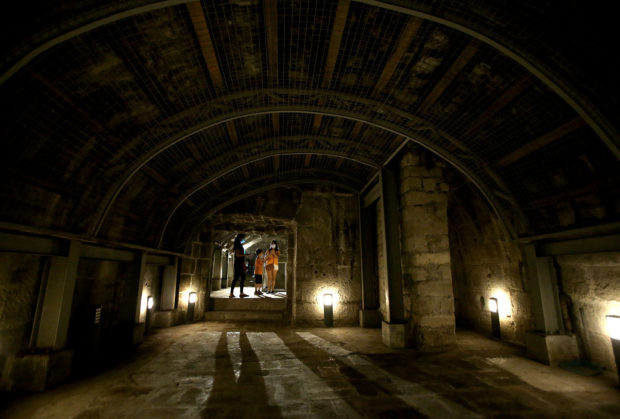Newly opened dungeon to give public ‘complete Fort Santiago experience’

People visit the newly opened dungeons at Fort Santiago in Intramuros, Manila. It was built as storage vaults and powder magazine of the Baluarte de Santa Barbara and was converted as a prison facility. More than 600 corpses where found by American forces during liberation of Manila against Japanese occupation. INQUIRER PHOTO / RICHARD A. REYES
MANILA, Philippines — At the end of World War II when the Japanese forces left Manila, American troops found around 600 decomposing bodies piled on top of each other inside a dungeon at Fort Santiago.
Experts believed that the dead men had been detained for guerrilla activities. Confined to a prison cell no bigger than 300 square meters, they were suspected to have died of either heat exhaustion or suffocation.
Last month, the Intramuros Administration opened the 16th-century underground cha¬m¬¬¬ber to the public to give them the “complete Fort Santiago experience.”
Guests will find the dungeon at Baluarte de Santa Barbara, just beside the Pasig River.
“The dungeon [is] important in the narrative of Fort Santiago because [it] serves a very important reminder. [It] reminds us of the atrocities of war, the horrors of war. We opened this in the hopes that maybe we can avoid another war,” said archivist John Arcilla of the Intramuros Administration.
Article continues after this advertisementAt the baluarte, visitors will notice a marble cross serving as a marker for the mass grave where the 600 were buried.
Article continues after this advertisementA few steps away are stairs that lead to the dungeon. Visitors will have to squat to enter the chamber since the entrance is small.
Only 10 people at a time can enter with kids age 12 and below barred from the area. Vandalism, horseplay, loitering and overstaying are strictly prohibited. The dungeon is about as old as Fort Santiago.
Its ceiling is made of dirt and lined with adobe stones. Before being opened to the public, workers had to reinforce the structure’s ceiling with steel to ensure that it would not collapse.
Since sunlight could not penetrate the dungeon, the Intramuros Administration had lights installed in the area. The dark and cold temperature combine for an eerie feeling.
The dungeon, composed of several rooms, was initially built as a storage facility for arms and gunpowder, Arcilla said.“However, it was not conducive to storage of gunpowder because it was near a body of water,” he added.
The ceiling of the dungeon absorbed moisture from above, with the water trickling down the walls, leaving puddles on the floor.Spanish soldiers eventually built a new storage facility and converted the vault into a holding cell.
Legend has it that the water from Pasig River would enter the dungeon during high tide, causing some prisoners to drown.But Arcilla said that this was just “black legend.”
“[There is no flooding] inside because the dungeon is above sea level,” he pointed out.Arcilla explained that the baluarte where the dungeon was located was actually in an elevated area. While visitors have to go down a set of stairs to enter, the chamber is at ground level.
Plenty of visitors have showed up at Fort Santiago since the dungeon was opened to the public, between 2 p.m. and 10 p.m. daily.
The Intramuros Administration is planning on opening a photo exhibit to provide more information for visitors.
“This dungeon serves to commemorate those who died in the war. It is very important that we open [it] because the experience of Fort Santiago will not be complete without [a] visit [to] the dungeon,” Arcilla said.